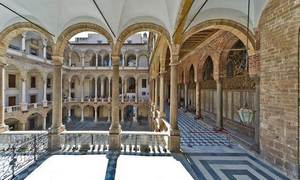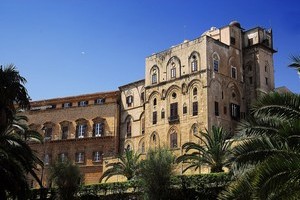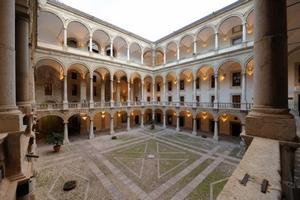Royal Palace - Bed and Breakfast Kemonia






Main menu:
Royal Palace
The Royal Palace in Palermo is located in the upper part of the city, near the cathedral, on a raised platform, it accentuates the grandeur and monumentality. Massimo emblem of the power of the Norman city, is with its ten centuries of history one of the most important monuments of the history of Palermo and Sicily. The origin of the Norman Royal Palace dates back to the second half of the eleventh century. Robert Guiscard, conquered Palermo in 1072, he built a castle to control the city just occupied.The construction built by Guiscardo will be the nucleus from which will develop later the Royal Palace of the Normans, built at the behest
 of Roger II in the early twelfth century, probably after his coronation in 1130. The Royal Palace in Palermo It presents an exceptional architectural palimpsest on which to refine twenty-five centuries of history. The Palace was both palace, citadel, real industry, fortitude, political prison. The north wing of the palace was made up of several parts connected to the Tower of Pisa: the Joharia (the "jeweled"), built by Roger and still partially exists today, deputy to the idleness and the entertainment of kings La Pisana tower It consists of a high and massive tower with a quadrangular plan, to which the ground floor there is the so-called "treasure room." at the center of the room there is a
of Roger II in the early twelfth century, probably after his coronation in 1130. The Royal Palace in Palermo It presents an exceptional architectural palimpsest on which to refine twenty-five centuries of history. The Palace was both palace, citadel, real industry, fortitude, political prison. The north wing of the palace was made up of several parts connected to the Tower of Pisa: the Joharia (the "jeweled"), built by Roger and still partially exists today, deputy to the idleness and the entertainment of kings La Pisana tower It consists of a high and massive tower with a quadrangular plan, to which the ground floor there is the so-called "treasure room." at the center of the room there is a large square tub with an imposing central block, for some deputed to conservation of the treasures of the rulers. Above this room there is a majestic and slender square-shaped hall covered with a large vault, today the office of the President of 'Sicilian regional Assembly, in whose walls are preserved some pieces of mosaics with architectural representations and subject animals (horses and birds ) interpreted as scenes of hunting or battle, that decorated a representative room probably intended to convivial and recreational functions. Same functions attributable to the "Sala dei Venti", also called "Four Columns" because of four massive columns that hold the ceiling at the center of this large and bright living part from Joharia instead. At the Sala dei Venti it is
large square tub with an imposing central block, for some deputed to conservation of the treasures of the rulers. Above this room there is a majestic and slender square-shaped hall covered with a large vault, today the office of the President of 'Sicilian regional Assembly, in whose walls are preserved some pieces of mosaics with architectural representations and subject animals (horses and birds ) interpreted as scenes of hunting or battle, that decorated a representative room probably intended to convivial and recreational functions. Same functions attributable to the "Sala dei Venti", also called "Four Columns" because of four massive columns that hold the ceiling at the center of this large and bright living part from Joharia instead. At the Sala dei Venti it is  connected to the so-called "Roger's Room", the king's representative space comparable in function to the throne area of the Palatine Chapel. Located between the wing of the royal residence and the Maqueda courtyard is the Palatine Chapel. Under the Palatine Chapel is the lower chapel, a small central-plan chapel is I'originaria Palace chapel. At the same level of the lower church, under the Courtyard of Fontana, there are some conventionally defined as "secret" environments, a series of small covered compartments, which are considered almost contemporary to the first Norman system, have not yet been defined with certainty the actual functions. Throughout the palace dominate constructive and Islamic decorative characters. The very design of the
connected to the so-called "Roger's Room", the king's representative space comparable in function to the throne area of the Palatine Chapel. Located between the wing of the royal residence and the Maqueda courtyard is the Palatine Chapel. Under the Palatine Chapel is the lower chapel, a small central-plan chapel is I'originaria Palace chapel. At the same level of the lower church, under the Courtyard of Fontana, there are some conventionally defined as "secret" environments, a series of small covered compartments, which are considered almost contemporary to the first Norman system, have not yet been defined with certainty the actual functions. Throughout the palace dominate constructive and Islamic decorative characters. The very design of the building as well as structured (palace-administrative citadel) follows Islamic prototypes, architectural features northern European can instead be read in vaults, in the very thick walls and in the system of walls and towers that was structured originally all the palace. With the Aragonese, in the second half of '200, the building was completely abandoned until the sixteenth century. After almost three centuries of neglect and decay, the end of the '500 the Viceroy Maqueda made to realize his large backyard porch at three elevations that bears his name; under Charles III (XVIII sec.) was renewed the grand staircase in red marble of Castellammare. In 1616 they ended the great architectural works of the Palace with the construction of a long liaison body between the Greek Tower and Pisana Tower with current late-Mannerist facade with three elevations which looks out on Piazza della Vittoria. Since 1941 is the seat of the Sicilian Regional Assembly, the governing body of the Sicily Region.
building as well as structured (palace-administrative citadel) follows Islamic prototypes, architectural features northern European can instead be read in vaults, in the very thick walls and in the system of walls and towers that was structured originally all the palace. With the Aragonese, in the second half of '200, the building was completely abandoned until the sixteenth century. After almost three centuries of neglect and decay, the end of the '500 the Viceroy Maqueda made to realize his large backyard porch at three elevations that bears his name; under Charles III (XVIII sec.) was renewed the grand staircase in red marble of Castellammare. In 1616 they ended the great architectural works of the Palace with the construction of a long liaison body between the Greek Tower and Pisana Tower with current late-Mannerist facade with three elevations which looks out on Piazza della Vittoria. Since 1941 is the seat of the Sicilian Regional Assembly, the governing body of the Sicily Region.





